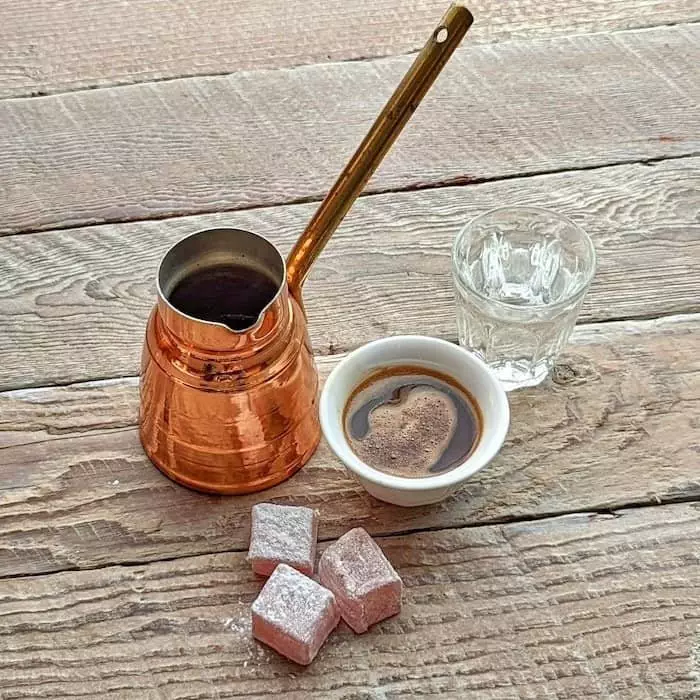To make authentic Turkish coffee, combine finely ground coffee, water, and sugar (optional) in a cezve (Turkish coffee pot), simmer until foam forms, then pour into a small cup, allowing the grounds to settle before serving.
Discover the Secret to Making Authentic Turkish Coffee at Home
Turkish coffee is a traditional and popular beverage that has been enjoyed in Turkey for centuries. It is known for its strong flavor, rich aroma, and unique preparation method. Turkish coffee has also gained popularity around the world, with coffee lovers appreciating its distinct taste and cultural significance.
In this article, we will explore the history of Turkish coffee, its importance in Turkish culture, the ingredients and equipment needed to make it.
The History of Turkish Coffee
The origins of Turkish coffee can be traced back to the 15th century when coffee was first introduced to the Ottoman Empire. It is believed that coffee was brought to Istanbul by Syrian traders and quickly gained popularity among the elite class. Over time, coffeehouses began to emerge throughout the city, becoming important social and cultural hubs where people would gather to drink coffee, play games, discuss politics, and engage in intellectual conversations.
Coffee soon became an integral part of Turkish culture and was even mentioned in Ottoman literature and poetry. It was considered a symbol of hospitality and was often served to guests as a sign of respect. The preparation and serving of Turkish coffee also became an art form, with skilled baristas known as “kahveci” taking pride in their ability to create the perfect cup of coffee.
The Importance of Coffee in Turkish Culture
Coffee plays a significant role in Turkish hospitality and social customs. It is customary for hosts to offer their guests a cup of coffee upon arrival as a gesture of welcome and friendship. In fact, there is a saying in Turkey that goes “A cup of coffee commits one to forty years of friendship.”
Coffee is also an important part of social gatherings and is often served after meals or during special occasions. It is seen as a way to bring people together and create a sense of community. In addition, coffeehouses continue to be popular meeting places where people can relax, socialize, and enjoy a cup of coffee.
Coffee also holds symbolic meaning in Turkish culture. The way the coffee grounds settle in the cup after it is consumed can reveal insights into the drinker’s future. This practice, known as “tasseography” or “coffee cup reading,” is still believed by some to provide glimpses into one’s destiny.
The Ingredients for Making Turkish Coffee
The key ingredient for making Turkish coffee is finely ground coffee beans. Turkish coffee is typically made from Arabica beans, which are known for their rich flavor and low acidity. The beans are ground to a very fine consistency, almost like powdered sugar, to ensure that they dissolve completely in the water during the brewing process.
Another important factor in making Turkish coffee is the quality of the water. It is recommended to use filtered or bottled water to ensure that there are no impurities that could affect the taste of the coffee. The water should be cold when it is added to the coffee pot.
Sugar is also commonly added to Turkish coffee, although it can be adjusted according to personal preference. Some people prefer their coffee unsweetened, while others enjoy it with varying degrees of sweetness. Additionally, spices such as cardamom or cinnamon can be added to enhance the flavor of the coffee.
The Equipment Needed for Making Turkish Coffee
The traditional equipment used for making Turkish coffee is a small copper pot called a “cezve” or “ibrik.” The cezve has a long handle and a wide base, allowing for even heat distribution during the brewing process. It is important to choose a cezve that is the right size for the amount of coffee you plan to make.
In addition to the cezve, you will also need a heat source, such as a gas stove or a hot plate. It is important to use low heat when brewing Turkish coffee to prevent it from boiling over.
Other equipment needed for making Turkish coffee includes a small spoon for stirring, a coffee grinder for grinding the beans, and demitasse cups for serving the coffee.
The Preparation Process for Turkish Coffee
To make Turkish coffee, start by measuring out the desired amount of cold water using the demitasse cups. For each cup of coffee, use one demitasse cup of water.
- Next, add the water to the cezve and place it on the heat source. Add one heaping teaspoon of finely ground coffee per demitasse cup to the cezve. If you prefer your coffee sweetened, add sugar to taste at this stage.
- Stir the mixture gently with a spoon until the coffee and sugar are dissolved in the water. Be careful not to stir too vigorously, as this can disrupt the formation of foam later on.
- Once the coffee is dissolved, increase the heat slightly and allow the mixture to come to a simmer. As it heats up, you will notice a layer of foam forming on top. This foam is an important part of Turkish coffee and adds to its unique texture and flavor.
- Just as the coffee is about to come to a boil, remove it from the heat source and let it sit for a few seconds to allow the foam to settle. Repeat this process two more times, bringing the coffee to a simmer and removing it from the heat just before it boils.
- After the third time, pour the coffee into demitasse cups, making sure to distribute the foam evenly among them. Allow the coffee to sit for a minute or two to allow any remaining grounds to settle at the bottom of the cup before serving.
Tips for Perfecting the Texture and Consistency of Turkish Coffee
While making Turkish coffee is relatively simple, there are a few common mistakes to avoid to ensure the perfect texture and consistency.
One common mistake is using too high heat during the brewing process. Turkish coffee should be brewed slowly over low heat to allow the flavors to develop and the foam to form. Using high heat can cause the coffee to boil over and result in a bitter taste.
Another mistake is stirring the coffee too vigorously. Gentle stirring is enough to dissolve the coffee and sugar in the water. Stirring too vigorously can disrupt the formation of foam and result in a less creamy texture.
The amount of foam in Turkish coffee can also be adjusted according to personal preference. If you prefer a thicker layer of foam, you can increase the number of times you bring the coffee to a simmer before removing it from the heat. If you prefer less foam, you can reduce the number of times or skip this step altogether.
The Art of Serving Turkish Coffee
Serving Turkish coffee is an art form in itself and involves careful attention to detail. Traditionally, Turkish coffee is served in small demitasse cups without handles. The cups are usually made of porcelain or glass and are often decorated with intricate designs.
When serving Turkish coffee, it is customary to present it on a tray along with a glass of water and a small sweet treat, such as a piece of Turkish delight or a sugar cube. The water is meant to cleanse the palate before drinking the coffee, while the sweet treat provides a contrast to the strong flavor of the coffee.
To serve the coffee, hold the cup by its rim and place it on the saucer. The saucer can then be held by its rim or by placing your thumb on top of it. This allows for easy transportation of the cup without spilling any of the precious liquid.
When presenting Turkish coffee, it is important to pour it slowly and carefully to avoid disturbing the foam. The coffee should be poured until it reaches the rim of the cup, but not overflowing. This ensures that the foam is preserved and adds to the visual appeal of the coffee.
Pairing Turkish Coffee with Traditional Turkish Sweets
Turkish coffee is often enjoyed with traditional Turkish sweets, which complement its strong flavor and provide a balance of sweetness. Some popular sweets to pair with Turkish coffee include baklava, Turkish delight, and kurabiye (Turkish cookies).
Baklava is a rich and sweet pastry made with layers of filo dough, nuts, and honey syrup. Its flaky texture and nutty flavor pair well with the strong taste of Turkish coffee.
Turkish delight, or “lokum,” is a gel-like confection made with sugar, starch, and various flavors such as rosewater, lemon, or pistachio. Its chewy texture and delicate flavors make it an ideal accompaniment to Turkish coffee.
Kurabiye are buttery cookies that come in various shapes and flavors. They are often served during special occasions or as a treat with tea or coffee. Their crumbly texture and subtle sweetness make them a perfect match for Turkish coffee.
Pairing coffee with sweets is deeply rooted in Turkish culture and is seen as a way to enhance the overall experience of drinking coffee. It provides a moment of indulgence and allows for the flavors of both the coffee and the sweets to be savored.
Health Benefits of Drinking Turkish Coffee
In addition to its rich flavor and cultural significance, Turkish coffee may also offer some health benefits when consumed in moderation.
One potential benefit of drinking Turkish coffee is its high antioxidant content. Antioxidants help protect the body against free radicals, which can cause damage to cells and contribute to chronic diseases such as heart disease and cancer.
Turkish coffee has also been found to have potential benefits for brain health. The caffeine in coffee can improve cognitive function, increase alertness, and enhance mood. It has also been associated with a reduced risk of neurodegenerative diseases such as Alzheimer’s and Parkinson’s.
Additionally, Turkish coffee may have a positive impact on liver health. Studies have shown that coffee consumption is associated with a lower risk of liver diseases such as cirrhosis and liver cancer.
However, it is important to note that these potential health benefits are based on moderate consumption of Turkish coffee. Excessive consumption of coffee can lead to negative effects such as increased heart rate, anxiety, and disrupted sleep patterns. It is recommended to limit coffee intake to no more than 3-4 cups per day.
Conclusion and Final Thoughts on Making Authentic Turkish Coffee at Home
In conclusion, Turkish coffee is a beloved beverage with a rich history and cultural significance. Its strong flavor, unique preparation method, and artful presentation make it a truly special experience.
To make authentic Turkish coffee at home, it is important to use finely ground Arabica beans, high-quality water, and the right amount of sugar and spices according to personal preference. The traditional cezve and demitasse cups are essential for brewing and serving Turkish coffee.
The preparation process involves slowly simmering the coffee over low heat, allowing the foam to form, and pouring it carefully into demitasse cups. Attention to detail is key when serving Turkish coffee, with the presentation on a tray and the inclusion of water and a sweet treat.
Pairing Turkish coffee with traditional Turkish sweets enhances the overall experience and provides a moment of indulgence. The potential health benefits of drinking Turkish coffee include its high antioxidant content, positive effects on brain health, and potential benefits for liver health.
In conclusion, making authentic Turkish coffee at home allows you to experience the rich flavors and cultural significance of this beloved beverage. Whether enjoyed alone or in the company of friends and family, Turkish coffee offers a moment of relaxation and connection. So, grab your cezve, grind your beans, and savor the experience of making and enjoying a cup of authentic Turkish coffee.
Originally posted 2024-02-25 05:30:04.







